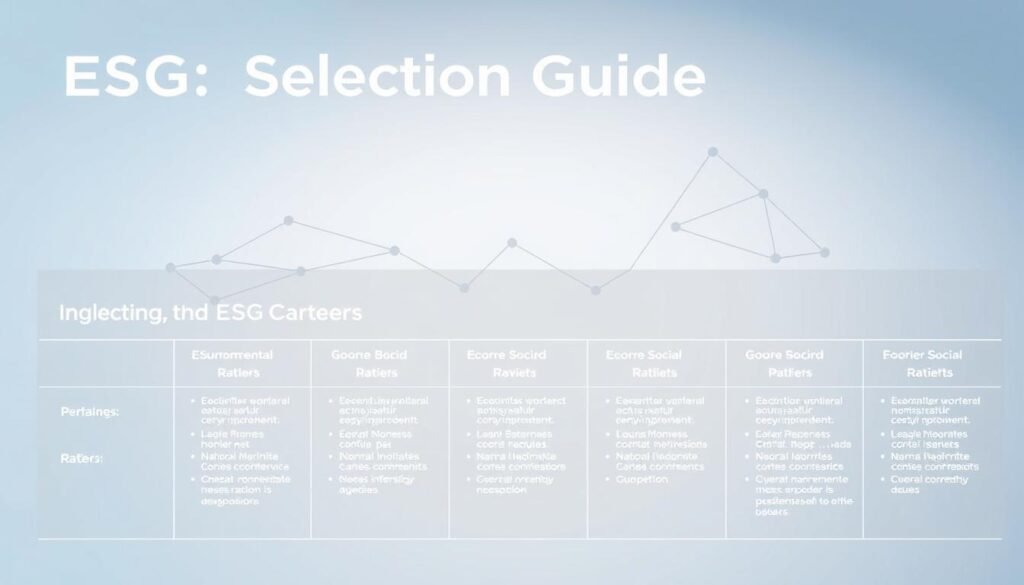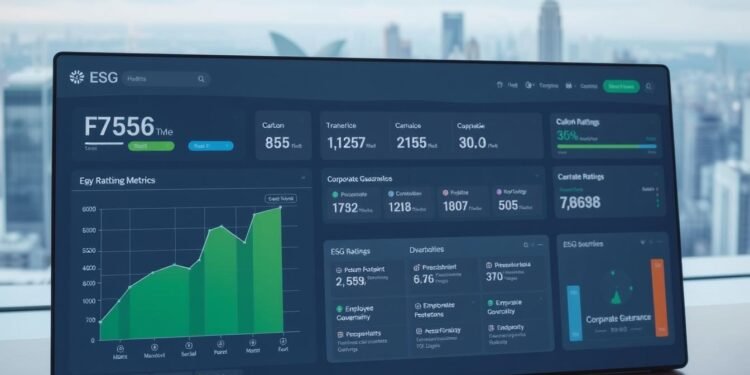What if the most critical factor in your investment strategy isn’t found on any financial statement?
Modern investors increasingly recognize that a company’s true value extends beyond profit margins. Comprehensive evaluations of environmental responsibility, social impact, and governance practices now shape investment decisions. These assessments measure how businesses manage long-term risks and opportunities.
This buyer’s guide empowers you to understand these critical metrics. You’ll learn how various stakeholders—from asset managers to corporations—utilize this data. We’ll explore calculation methods, leading providers, and improvement strategies.
Both quantitative and qualitative information combine to create a holistic view of corporate sustainability. This approach helps assess performance where traditional analysis falls short.
Key Takeaways
- These evaluations measure environmental, social, and governance practices beyond financial data
- They help identify long-term risks and opportunities for businesses
- Multiple stakeholders including investors and regulators use these assessments
- The ratings combine both numerical data and qualitative reporting
- Understanding these metrics supports more informed investment decisions
- Companies can use these evaluations to improve their sustainability performance
What Are ESG Ratings? A Foundational Definition
Beyond traditional financial metrics lies a new dimension of corporate evaluation that’s reshaping investment landscapes. These comprehensive assessments measure how companies manage their broader impact and long-term sustainability practices.
Breaking Down the E, S, and G Components
The environmental component examines a company’s relationship with nature. It evaluates carbon emissions, energy efficiency, and waste management systems. Climate considerations and resource conservation are key factors in this analysis.
Social metrics focus on human capital and community relationships. They assess labor practices, diversity initiatives, and customer satisfaction. Community engagement and employee wellbeing form crucial elements of this evaluation.
Governance examines leadership structures and ethical frameworks. It reviews board independence, anti-corruption measures, and decision-making transparency. Strong governance practices help mitigate various business risks.
ESG Ratings vs. ESG Scores: Understanding the Terminology
While often used interchangeably, these terms represent different assessment approaches. Ratings typically use categorical systems like AAA or BB classifications. They provide relative rankings within industry peer groups.
Scores offer numerical values on standardized scales, often ranging from 0-100. This granular approach allows for precise benchmarking and trend analysis. Both methods aim to quantify exposure to sustainability issues.
Specialized agencies like MSCI and Sustainalytics develop these evaluations. They use industry-specific criteria and multiple data sources. Understanding this distinction is vital for accurate interpretation and informed decisions.
These metrics serve as valuable tools for risk management and value creation. They help investors and companies identify improvement opportunities. Clear terminology prevents confusion when comparing different providers or integrating data into strategic planning.
The Growing Importance of ESG Ratings in Modern Investing
Investment strategies have undergone a remarkable transformation in recent years, with sustainability metrics becoming central to decision-making. What began as a specialized interest among ethical investors has evolved into a core component of mainstream financial analysis.
From Niche Concern to Mainstream Investment Factor
Regulatory changes and growing stakeholder demands have propelled these assessments into the investment spotlight. Institutional investors now prioritize comprehensive sustainability performance as a key criterion for their decisions.
This shift reflects broader awareness of climate issues and social responsibility. Companies facing increased scrutiny must demonstrate robust management practices across all operational areas.
The financial benefits of strong performance in this area are increasingly documented. Organizations with better sustainability profiles often experience lower cost of capital and enhanced brand reputation.
How Strong ESG Performance Drives Long-Term Value
Comprehensive sustainability analysis helps identify companies positioned to handle future challenges. These businesses typically show improved operational efficiency and better risk management capabilities.
Research indicates correlations between high scores and superior financial outcomes. Studies demonstrate that companies with strong sustainability practices often outperform peers in profitability and growth rates.
These evaluations help investors avoid organizations with unmanaged risks. This approach reduces potential losses from regulatory penalties or reputation-damaging incidents.
Integration of these metrics allows for more resilient portfolio construction. Investors can balance financial returns with sustainability objectives effectively.
Strong performance in this area frequently drives innovation through sustainable product development. Companies adopting advanced technologies often see improved long-term value creation.
These comprehensive assessments are no longer optional but essential for modern investment analysis. They provide critical insights beyond traditional financial metrics.
How ESG Ratings Are Calculated: A Look Inside the Methodology
Behind every corporate sustainability assessment lies a complex calculation process that transforms raw data into actionable insights. This systematic approach ensures evaluations reflect actual business practices and risk exposure.
Data Collection: Company Disclosures and External Sources
Rating agencies gather information from multiple channels to build comprehensive profiles. Company-provided data includes sustainability reports, policy documents, and regulatory filings.
External sources complement this information with third-party perspectives. News media, regulatory bodies, and non-governmental organizations provide additional context.
Certifications like ISO 14001 offer verified evidence of management systems. This multi-source approach creates a robust foundation for evaluation.
Materiality Assessment: Identifying Industry-Specific Risks
Not all sustainability factors carry equal importance across different sectors. Materiality assessment identifies which issues matter most for specific industries.
Packaging waste represents a critical concern for beverage companies but less so for technology firms. This tailored approach ensures evaluations reflect actual business risks.
The process determines which environmental, social and governance factors deserve focus. Industry-specific criteria prevent irrelevant metrics from distorting results.
Weighting, Scoring, and the Final Rating Output
Different issues receive varying levels of importance based on their potential impact. Immediate risks with severe consequences carry greater weight than longer-term concerns.
Worker safety in manufacturing receives higher priority than distant climate goals. This weighting system reflects real-world risk priorities.
Scoring involves analyzing both exposure and management effectiveness. Companies receive numerical values typically ranging from 0-10 for each key issue.
Final aggregation combines weighted scores into an overall numerical value. This value then converts into categorical ratings like AAA through CCC classifications.
Leading providers like Morningstar Sustainalytics use multi-dimensional assessments. They measure exposure and management of over 20 industry-specific material risks.
MSCI analyzes numerous exposure and governance metrics across different timeframes. Both approaches emphasize transparency in their methodological frameworks.
Understanding this calculation process helps users critically evaluate assessment reliability. It supports more informed application of these metrics in decision-making.
Primary Applications of ESG Ratings for Investors and Businesses
Investment portfolios and corporate strategies now leverage sustainability assessments to create competitive advantages. These tools provide actionable insights that drive better outcomes across financial and operational domains.
Informing Investment Decisions and Portfolio Construction
Asset managers integrate these evaluations into their fundamental analysis. They screen for companies demonstrating strong sustainability performance.
This approach helps identify organizations with better risk management practices. Investors can then tilt their portfolios toward industry leaders.
Some focus on specific issues like climate change or diversity. Others seek broad excellence across all sustainability dimensions.
This process supplements traditional financial analysis with forward-looking indicators. It creates more resilient investment strategies.
Enhancing Risk Management and Strategic Planning
Businesses use these assessments to identify potential vulnerabilities in their operations. The analysis reveals environmental, social and governance risks that might otherwise remain hidden.
Companies then develop strategies to address these exposure points. This might involve reducing carbon footprint or improving labor practices.
Strategic planning benefits from this comprehensive risk perspective. Organizations can prioritize initiatives that drive sustainable growth while mitigating potential threats.
This approach enhances operational resilience and creates long-term value. It transforms sustainability from compliance to competitive advantage.
Meeting Regulatory Requirements and Stakeholder Demands
Regulators worldwide now mandate sustainability disclosures for companies. These evaluations help organizations demonstrate compliance with evolving standards.
Financial Conduct Authority frameworks and similar regulations require transparent reporting. Companies use these assessments to meet these requirements effectively.
Stakeholders including investors, customers and employees demand greater transparency. Sustainability metrics provide objective evidence of performance and progress.
Supply chain partners also utilize these evaluations. Sustainable suppliers often receive better financing terms and preferred partnership status.
Asset managers prioritize engagement based on performance data. This active ownership approach drives continuous improvement across industries.
These versatile tools serve multiple functions across investment and corporate environments. They enable holistic integration of sustainability considerations into core business decisions.
Leading ESG Rating Agencies and Their Methodologies
Several organizations specialize in evaluating corporate sustainability. These firms use distinct approaches to measure environmental, social, and governance factors.
Their assessments help investors and businesses understand risk exposure. Each provider offers unique insights into company practices.
An Overview of Major Providers like Sustainalytics, MSCI, and Others
Morningstar Sustainalytics stands out for its comprehensive risk evaluation. It covers over 16,000 companies worldwide.
The firm uses a multi-dimensional assessment of material risks. It categorizes risk into five levels from negligible to severe.
MSCI analyzes more than 8,500 companies using industry-specific criteria. Its framework examines 33 key issues across different sectors.
Ratings range from CCC to AAA based on weighted factors. This approach considers both impact and timeline of various risks.
S&P Global integrates sustainability metrics into credit risk analysis. It provides valuable insights for financial decision-making.
EcoVadis focuses specifically on supply chain evaluations. It uses certifications and audit reports in its assessment process.
Moody’s offers solutions that combine traditional credit analysis with sustainability factors. Each provider brings specialized expertise to the field.
Key Features to Look For in a Rating Provider
Coverage breadth represents a critical consideration when selecting a provider. Some firms focus on public equity while others include private companies.
Methodology transparency ensures you understand how evaluations are calculated. Providers should clearly disclose data sources and weighting schemes.
Industry relevance means the assessment reflects sector-specific risks. A good provider tailors its criteria to different business environments.
Data robustness comes from using multiple verification sources. Strong providers combine company disclosures with external validation.
Additional features like historical data enable performance tracking over time. API access allows integration with existing analysis platforms.
Specialization matters when matching provider strengths to your needs. Investors might prefer broad coverage while businesses value supply chain focus.
Choosing the right provider ensures accurate and actionable insights. This decision directly impacts the quality of your sustainability analysis.
Interpreting ESG Risk Ratings and Company Reports
Numbers alone don’t tell the full story of corporate sustainability. Effective interpretation requires understanding both quantitative scores and qualitative context. This deeper analysis reveals true risk exposure and management effectiveness.

Understanding Risk Levels: From Negligible to Severe
Risk categories help investors quickly assess potential exposure. The five-level scale ranges from negligible to severe.
Negligible risk indicates minimal exposure with little financial impact. These companies face few sustainability challenges.
Low risk shows some exposure but effective management controls. Medium risk suggests moderate exposure with partial management.
High risk signals significant exposure with inadequate controls. Severe risk represents critical unmanaged exposure.
These levels help compare companies within the same industry. Investors can quickly identify potential problem areas.
Analyzing Management Gaps and Unmanaged Risks
Management gaps occur when companies lack proper policies. These gaps often lead to controversies or operational issues.
Unmanaged risk represents the portion remaining after management efforts. It forms the basis of the final risk score.
For example, a company with high emissions but weak controls has large gaps. This results in high unmanaged climate risk.
Industry context matters greatly in this analysis. Water stress matters more for beverage companies than tech firms.
Company reports provide crucial qualitative insights. They explain exposure reasons and management effectiveness.
Look for risk decomposition in these documents. This shows how much risk is exposed versus managed.
Event sections detail incidents affecting performance. These might include controversies or positive initiatives.
Combining scores with reports offers complete understanding. The numbers provide snapshots while reports explain trends.
Effective interpretation identifies improvement opportunities. It helps prioritize engagement areas for maximum impact.
This approach transforms raw data into actionable intelligence. It supports better investment decisions and corporate strategy.
Challenges and Criticisms in the ESG Rating Landscape
While sustainability assessments offer valuable insights, the landscape faces significant challenges that require careful navigation. These evaluation systems must overcome several hurdles to maintain credibility and usefulness.
Addressing Data Gaps and the Problem of Greenwashing
Inconsistent disclosure practices create substantial data challenges. Smaller companies and emerging markets often lack comprehensive reporting frameworks.
This information gap can lead to inaccurate scores. Rating agencies must rely on limited external data sources for these entities.
Greenwashing presents another serious concern. Some organizations implement superficial sustainability practices primarily to inflate their scores.
This requires rigorous verification processes from assessment providers. They must distinguish between genuine commitment and marketing efforts.
The Debate on Standardization and Rating Reliability
Different agencies employ varying methodologies and weighting systems. This lack of uniform standards creates divergent evaluations for the same company.
The Sberbank case highlighted this inconsistency dramatically. Russian-backed entities received high scores before sudden downgrades during the Ukraine conflict.
Retroactive adjustments have raised questions about evaluation objectivity. Research from the European Corporate Governance Institute documented these reliability challenges.
Regulatory bodies like the UK’s Financial Conduct Authority now push for standardization. Their initiatives aim to create consistency and build trust in these assessments.
Industry providers are responding with improved approaches. Many now incorporate artificial intelligence and better data integration techniques.
Users should cross-reference multiple sources and understand methodology differences. This critical evaluation helps avoid misinterpretation of sustainability performance.
Transparency from both companies and rating agencies remains essential. Open communication about data sources and calculation methods addresses many concerns.
While challenges persist, ongoing improvements are making these evaluations more robust. The field continues evolving toward greater reliability and value for all stakeholders.
Strategies for Companies to Improve Their ESG Score
Corporate leaders seeking competitive advantage now recognize sustainability as a core business imperative rather than optional compliance. Effective improvement requires coordinated efforts across environmental, social, and governance dimensions.
Successful organizations integrate these considerations into their fundamental operations. They align sustainability goals with financial objectives for cohesive growth.
Actionable Steps for Environmental Performance
Environmental improvements begin with energy transformation. Companies should invest in renewable sources like solar and wind power.
Adopting energy-efficient technologies reduces operational costs while lowering carbon footprint. These investments often provide rapid returns through reduced utility expenses.
Carbon offset programs complement direct reduction efforts. They help balance unavoidable emissions through verified environmental projects.
Waste management represents another critical area. Organizations can optimize resource usage through circular economy principles.
Robust recycling programs minimize landfill contributions. They also create potential revenue streams from reclaimed materials.
Transparent environmental reporting builds credibility with stakeholders. Companies should publish clear data about their climate impact and reduction progress.
Initiatives to Boost Social and Governance Metrics
Social performance improvements start with workforce development. Companies should develop comprehensive policies for diversity and inclusion.
Providing mental health support and ensuring fair labor practices strengthens employee retention. These measures also enhance productivity and innovation.
Community engagement creates positive social impact. Organizations can support local initiatives through partnerships and volunteer programs.
Charitable contributions should align with business values and community needs. This strategic approach maximizes social benefit.
Governance enhancements begin with ethical frameworks. Companies must establish strong anti-corruption measures and ensure board independence.
Creating channels for stakeholder feedback improves decision-making transparency. Independent oversight committees help maintain accountability.
Certifications demonstrate commitment to recognized standards. Pursuing ISO 14001 for environmental management or ISO 26000 for social responsibility validates improvement efforts.
Microsoft’s carbon-negative goal showcases environmental leadership. Diversity programs in leading technology firms demonstrate social progress.
Continuous improvement and transparency remain essential for rising sustainability scores. Organizations that embed these practices into their core strategy reap significant benefits.
Strong performance creates business value through enhanced reputation and stakeholder trust. It also identifies new opportunities for growth and innovation.
A Buyer’s Guide to Selecting and Using ESG Ratings
Choosing the right sustainability assessment tools requires careful consideration of your specific needs and goals. This guide helps you navigate provider options and integration methods for maximum value.

Defining Your Objectives: What Do You Need the Ratings For?
Start by clarifying your primary purpose for using these evaluations. Different applications require distinct approaches and data types.
Investment screening focuses on identifying companies with strong risk management. This helps build resilient portfolios with better long-term potential.
Corporate benchmarking measures your performance against industry peers. It reveals improvement opportunities and competitive positioning.
Regulatory reporting requires specific data formats and verification standards. Choose providers that align with disclosure requirements.
Supply chain evaluation assesses partner sustainability practices. This reduces exposure to external risks through better vendor selection.
Evaluating Providers Based on Coverage, Methodology, and Transparency
Coverage breadth determines how many companies and sectors a provider assesses. Some firms focus on public equities while others include private entities.
Methodology transparency ensures you understand how scores are calculated. Look for clear documentation of data sources and weighting systems.
Industry alignment means the assessment reflects sector-specific material issues. A good provider tailors its criteria to different business environments.
Data robustness comes from using multiple verification sources. Strong providers combine company disclosures with external validation.
Historical data enables performance tracking and trend analysis. This supports backtesting of investment strategies and improvement measurement.
Integrating Ratings into Your Existing Financial Analysis
Combine sustainability metrics with traditional financial analysis for comprehensive insights. Adjust valuation models to incorporate risk premiums based on performance scores.
Portfolio construction benefits from screening out high-risk companies. You can also tilt allocations toward industry leaders in sustainability practices.
Engagement strategies prioritize discussions with companies showing management gaps. Active ownership drives improvement through targeted dialogue.
Data access options include feeds, APIs, and platform integrations. Choose methods that fit your existing analysis systems and workflows.
Cross-reference multiple providers to mitigate individual biases. This balanced approach provides more reliable assessment of company performance.
Asset managers might use MSCI for equity selection while corporations choose EcoVadis for supplier assessments. Align tool selection with your specific objectives for optimal results.
Conclusion: The Integral Role of ESG Ratings in Sustainable Finance
Sustainability assessments are now central to modern finance. They help investors and companies manage long-term risks and uncover new opportunities.
These tools align investments with global goals like reducing carbon emissions. They also support better business decisions and innovation.
Despite some challenges, the field is evolving. Greater transparency and improved data are making these metrics more reliable.
Looking ahead, these evaluations will keep shaping corporate responsibility. They drive value creation and support a more sustainable economy.
Use this guide to integrate these insights into your strategy. Make informed choices that balance financial returns with positive impact.
FAQ
What exactly are environmental, social, and governance ratings?
These assessments measure a company’s performance and risk exposure across environmental, social, and governance criteria. Providers evaluate factors like carbon emissions, labor practices, and board diversity to create a comprehensive sustainability profile.
Why have these assessments become so important for investors?
Investors now recognize that strong sustainability performance correlates with better risk management and long-term financial returns. These evaluations help identify companies well-positioned for future regulatory changes and consumer preferences.
How do rating agencies calculate these evaluations?
Agencies collect data from company reports, public records, and media sources. They apply industry-specific materiality assessments and weighting systems to generate final scores that reflect both performance and risk levels.
What’s the difference between a rating and a score in this context?
Scores typically represent numerical values based on performance metrics, while ratings often incorporate risk assessments and may use letter grades or categories. Both aim to quantify sustainability performance but through slightly different methodologies.
How can businesses use these evaluations to improve their operations?
Companies can identify performance gaps, benchmark against peers, and develop targeted improvement strategies. These assessments provide valuable insights for enhancing transparency, managing risks, and creating long-term value.
What should investors look for when choosing a rating provider?
Consider the provider’s methodology transparency, industry coverage, and data sources. Look for agencies that offer clear explanations of their assessment process and demonstrate understanding of sector-specific material issues.
How reliable are current sustainability assessments given data challenges?
While improvements continue, challenges remain regarding data consistency and comparability. Investors should use multiple sources and consider these evaluations as one component of comprehensive analysis rather than standalone decisions.
Can companies improve their sustainability performance quickly?
Meaningful improvement requires strategic commitment and systematic changes. Companies should focus on material issues for their industry, enhance disclosure practices, and implement robust management systems rather than seeking quick fixes.





